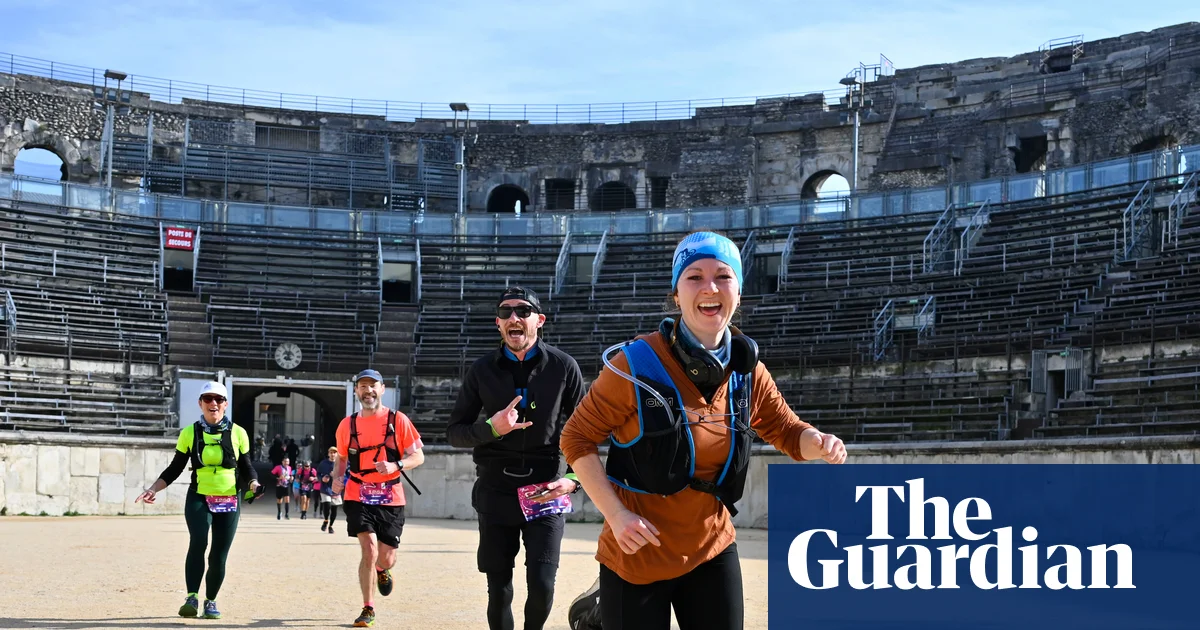We could hear the band before we saw it: a group of retirement home residents with trumpets and drums waiting to greet us as we approached. Others using wheelchairs waved homemade flags. As we swarmed into the building and up the staircase, a bottleneck formed. I slowed down as a nurse put a stamp on my sweaty arm, then I jogged off down the corridor.
Running through a retirement home is just one of the many surreal moments that participants signing up for the Nîmes Urban Trail (NUT) get to experience on this 24km race around the city, which takes place each February. Not only does the route give you a whistlestop sightseeing tour, taking you past the town’s impressive Roman monuments and landmarks, it also grants you access to places that would normally be off limits to outsiders.
Earlier in the day, I’d cantered through the lobby and bar of a five-star hotel, a Michelin-starred restaurant, the hôtel de ville (city hall), a barracks, a chapel and an olive grove. I even ran through a nightclub – easily the most wholesome sweat I’d ever worked up there. The school classrooms were particularly fascinating: I moved to France aged 28 so I’d never seen the inside of a French primary school. The retro maps pasted to the walls were the same pink as French toilet paper.
Crowds had gathered to cheer us on at various points along the route, but nowhere was the welcome more enthusiastic than at the retirement homes where the residents and carers had spent weeks preparing for our arrival. As I left the building, I realised my cheeks were damp – but not from sweat. This was the first time a running race had moved me to tears.
Running tourism has been gaining momentum for years. A third of participants in the Paris Marathon aren’t French, and in the Berlin Marathon, roughly two-thirds are from outside Germany. A recent survey found that 18% of Britons were planning to travel abroad for sports this year, many to take part in marathons, half-marathons and triathlons. Urban trail running, however, has really taken off in France, and 98% of NUT runners in 2025 were French.
Europe’s first organised urban trail run was in my home city, Lyon, in 2008. I’ve participated in the Lyon Urban Trail for the last three years, pounding up and down stairs, helter-skeltering down the muddy slope of the city’s former ski piste, la Sarra, and jogging through the grounds of old forts. It’s enormous fun, and now there are more than 100 urban trail runs in France, but none quite like Nîmes.
At the starting line I checked out my fellow competitors. I was sandwiched between Queen Elizabeth II and a couple of gladiators. Many of the fancy dress outfits had a Nîmois theme. Nîmes became part of the Roman empire around the first-century BCE, when it was known as Colonia Nemausus, and alongside the emperors and gladiators, I saw crocodiles and palm trees. Crocodiles may be about as native to Nîmes as lions and unicorns are to Great Britain, but they’ve become the symbol of the city. In the 16th century, a Roman coin showing a crocodile and a palm frond, to depict Roman victory over Egypt, was unearthed here. Now the Nîmois crocodile appears on paving stones and fountains, and there are even four stuffed ones hanging from the ceiling of the hôtel de ville.
Although my running attire was relatively dull, the race promised to be anything but. The people running the full marathon had been released into the (urban) wild half an hour earlier; I, surrounded by gladiators and crocodiles, was about to tackle the shorter, but still hilly, 24km race. After us would come runners participating in the 16km and 10km races, and finally the 10km hikers (breaking into a trot was strictly forbidden), so there’s something for all fitness levels and abilities.
When he co-founded the NUT 10 years ago, Benoît Goiset was clear he wanted to create something more than just a calf-buster. He envisioned a run that broke down social barriers and got the whole city involved.
after newsletter promotion
The route changes each year, with new and unusual sites being added. “After the pandemic we were seeing an epidemic of loneliness, so I added in the EHPADs [retirement homes],” said Goiset. “The five-star hotels and Michelin-starred restaurants were [included] because so few people get to experience them, particularly people who live in Nîmes. I didn’t want anywhere to be off limits.”
At the end of the race, we burst into the Roman arena with a rush of pride, feeling like warriors, to be greeted by trestle tables loaded with snacks and beer and lemonade. This had been my first full day in Nîmes, and I’ve never had such a complete introduction to a city. Not only had I seen all the Roman sites – the arena, Tour Magne (watchtower), the Temple of Diana and even the Musée de la Romanité (we ran across the roof terrace) – I’d also had a glimpse of “the real Nîmes”, behind closed doors. I’d seen where children go to school, where soldiers train, and where some of the city’s older residents spend their later years. The tiered Jardins de la Fontaine, an 18th-century park full of stone fountains set over canals, was so beautiful that as soon as my legs had recovered that afternoon, I went back again.
At the risk of sounding like so many obnoxious yogis, who told me the reason I don’t like yoga is that I haven’t found the right class, if you don’t like running, perhaps you haven’t found the right race.
Registration is open for the next Nîmes Urban Trail, which takes place on 15 February 2026. Prices vary depending on distance, but the 24km trail run is €38pp. Appart’City is opposite the race start line, with double rooms from €105 (room only).
